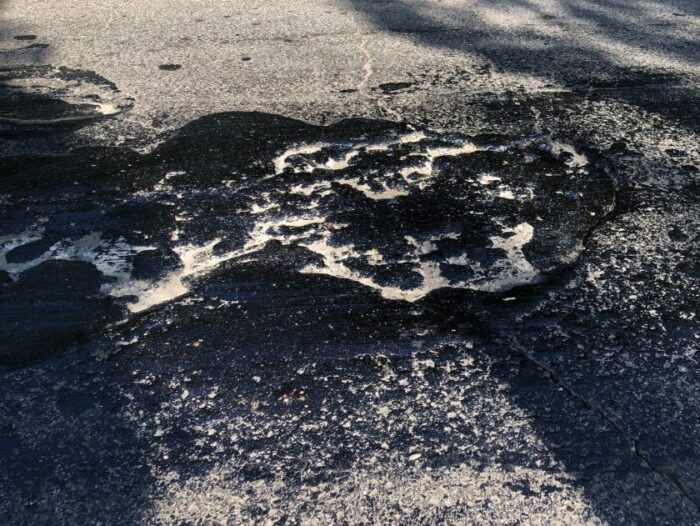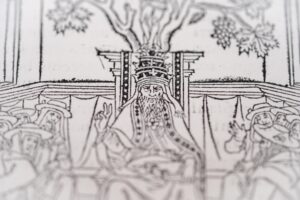Imagine you are a child in the 1980s and 1990s. You are driving home from school one day, and you and your family get stuck in afternoon traffic. This is a normal routine…until it’s not. What is usually an hour or so turns into several. Urgent car horns start piercing the air, and drivers get impatient. On investigation, they find the culprit: a black sticky substance emerging from the road with a mind of its own.
Background
La Mancha Negra’s place in Venezuelan collective memory is debatable. While some remember it as the source of a nationwide panic alongside the growing political and social ills, others can’t recall such an event taking place at all. Whatever the origin, La Mancha Negra began to dominate local and foreign newspapers.
The Spanish words, La Mancha Negra, translate to “the black stain.” It began appearing in 1986 on the Autopista Caracas-La Guaira, a major highway linking the capital to the coast in northern Venezuela, and continued to show up throughout the 1990s and early 2000s.
The goo’s texture is described as thick, greasy, and gummy, which turns “slick as ice” in certain conditions. When the temperature was very hot, the goo turned very slippery. When it cooled down, the goo became harder and manageable. Regardless, it was enough to do serious damage.

La Mancha Negra has a sticky, gum-like texture. Photo: Gypsy Thread
1,800 deaths??
What seemed like an isolated case of oil spillage 50m long quickly grew into something much more troubling. The substance spread rapidly, covering over 12 kilometers of highway. La Mancha was oozing from underground, moving and growing like it was alive, the more people drove on the roads. Reports claimed 1,800 people died as a result of the mysterious goo. Over time, La Mancha Negra expanded into other highways around Caracas, with reports of accidents increasing wherever the stain appeared.
The government, hearing its citizens cry for an explanation and solution, boasted to have spent millions of dollars on scientific studies and cleaning efforts. Supposedly, European, American, and Canadian governments provided equipment and expertise, attempting to remove it. Detergents, high-pressure hoses, and even resurfacing the roads proved largely ineffective. The goo just kept seeping through the ground. One strategy that seemed to work temporarily was covering the goo with pulverized limestone. The substance dried up…until the limestone dust made the city’s breathing quality unbearable. To make matters worse, the patches reappeared and got bigger. Answers were nowhere near being solved.
Composition
According to the “studies,” the substance consisted of dust, oil from cars, and other organic material. This theory proposed that poor-quality asphalt, combined with tropical humidity and heat, caused the road to deteriorate and leach out oily byproducts.
Author Ana Elena Azpurua, who compiled reports and chronicles about the highway, stated that the Ministry of Transport hypothesized:
It is a black stain caused by the interaction of spilled oil with “fresh” asphalt, which, because it was recently laid, is highly susceptible to temperature and has not aged or oxidized. This asphalt was laid in 1990, when the section from Pariata and Viaduct No. 3 to Catia was repaved.
A Wall Street Journal article from 1996 reported:
…due to the cheap gasoline prices in the country, Venezuelans would drive dated gas guzzlers, stating ‘Locals call the highway “la mancha negra,” or the black stain, because it literally shines with the oil drippings of thousands of big cars that labor up an incline into the city each day.
Explanations
Let us consider Venezuela’s geography for a second. Venezuela lies on a fault line between the South American Plate and the Caribbean Plate. This fault line results in earthquakes and makes Venezuela a hotspot for hydrocarbon reserves of oil, gas, petroleum, and natural asphalt.
Like its neighbor, Trinidad, Venezuela has an asphalt lake called Lake Bermudez. Though Lake Bermudez is quite far from the capital, it shows that Venezuela as a whole sits on a bed of hydrocarbons. Petroleum and oil seeps are quite common in these areas.
In the case of La Mancha Negra, it probably began to penetrate the asphalt. Why? Because the roads were poorly paved from the very start. Some suspected underground water seepage was mixing with road materials and automotive waste to create the greasy sludge. The fact that the goo reappeared showed that the underlying problem, particularly underground, was not dealt with.

Oil/tar pit in California. Photo: Daniel Schwen
Geologist K.H. James in his study, The Venezuelan Hydrocarbon Habitat, wrote:
Venezuela forms part of an important hydrocarbon province, defined by the presence of prolific Cretaceous source rocks, which extends across northern South America. By early 1997, the country had produced 53 billion barrels of oil. Reserves are estimated to total 73 billion barrels of oil and 146 TCF of gas with 250 billion barrels recoverable in the Heavy Oil Belt.
Conspiracy theories
Even before La Mancha, it was public knowledge that the roads were neglected, poorly constructed, and posed a public safety issue. The asphalt cracked and broke away in several areas, leading to rushed and rudimentary patches along the highway. It is very possible that oil seeped through the cracks. Unfortunately, government corruption mismanaged basic infrastructure.
That should have put the matter to rest, right? Sadly, it is not as simple. Due to the unstable political situation, news about La Mancha Negra was heavily influenced by media bias and conspiracy theories.
Why were the “studies” not made public? Did they even happen? Why is most information so scarce? If they knew what the substance was, why was the incident left so open-ended?
La Mancha Negra as a political tool
La Mancha appeared at a rather precarious time in the country’s political history. More conspiratorial ideas have included sabotage by political enemies or criminal organizations attempting to destabilize Caracas traffic or even reduce voter turnout during election seasons by making travel more dangerous.
The two presidents of Venezuela at the time of La Mancha Negra were Jaime Lusinchi and Carlos Andres Perez. Both were accused of corruption. Perez himself made allegations that La Mancha was a ploy by his political opponents to discredit him and blame him for mismanagement.
In 1992, Hugo Chavez, who eventually became president, attempted a coup to overthrow him. Supposedly, the opposition hired homeless people to spread the goo all over the roads under the cover of darkness. This was most likely a lie. The La Mancha Negra story died eventually, even to the point where people forgot it existed or believed it was an urban legend.
Conclusion
La Mancha Negra became more than just a public safety issue — it was a symbol of infrastructural and political decay in Venezuela. As the country faced mounting unrest, inflation, and corruption scandals from its leaders, La Mancha Negra stood as a visible and dangerous reminder of neglect.






